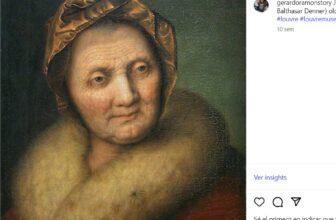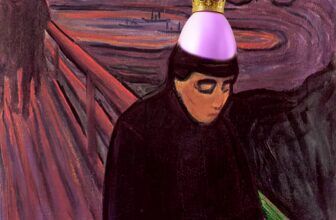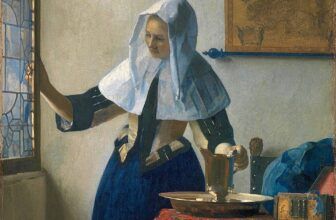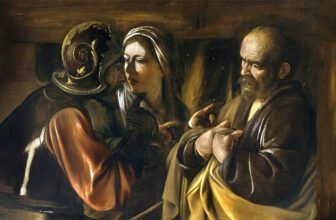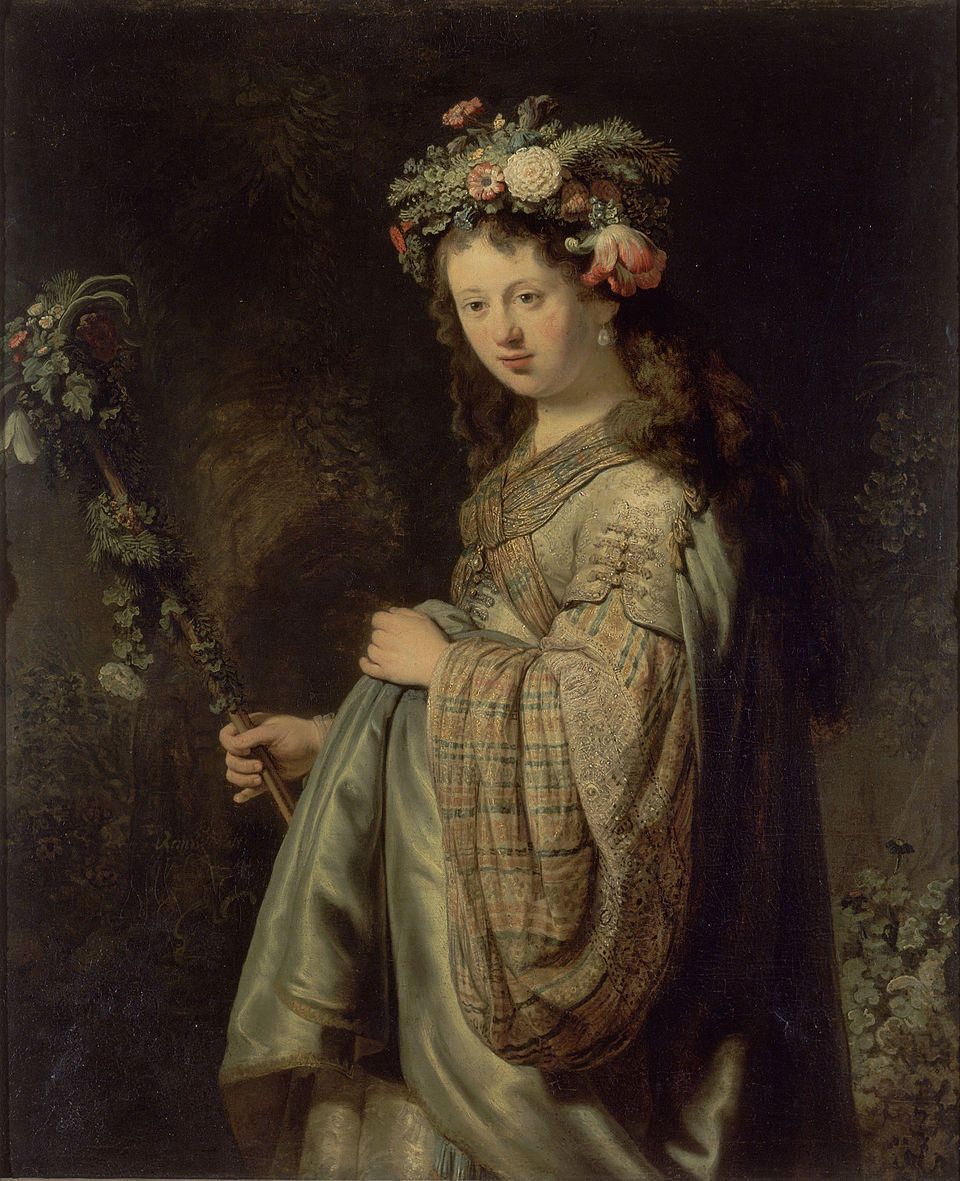
The Analysis and Meaning of Flora Painting by Rembrandt
Among Rembrandt van Rijn’s wide-ranging oeuvre, the portrait known as Flora occupies a particularly fascinating place. Painted around 1654, the work depicts the Roman goddess of spring and flowers in a sumptuous and enigmatic style, raising questions of identity, symbolism, and artistic intention. Today housed in the Hermitage Museum in St. Petersburg, Flora remains one of the Dutch master’s most captivating, and controversial, works. Its rich colors, layered symbolism, and debated interpretations make it not just an aesthetic marvel but also a key text for understanding Rembrandt’s shifting personal and artistic life during the mid-17th century.
In this essay, we will take a deep dive into Flora, analyzing its meaning, technique, controversies, and lasting cultural resonance. We will explore why this painting continues to intrigue historians and audiences alike, what it represents in the wider context of Rembrandt’s career, and what it reveals about the interplay between myth, portraiture, and personal history.
Rembrandt Harmenszoon van Rijn (1606–1669) is often celebrated as one of the greatest painters of the Dutch Golden Age. His ability to capture human emotion, spiritual intensity, and subtle naturalistic detail is unparalleled. By the 1650s, however, his career had entered a turbulent phase. Financial struggles, shifting artistic tastes, and personal losses marked this decade. Yet in the midst of these difficulties, Rembrandt produced Flora, a lush and deeply symbolic representation of spring, fertility, and renewal.
The painting depicts a woman dressed in rich garments, crowned with a wreath of flowers, and carrying a staff adorned with blossoms. She is identifiable as Flora, the Roman goddess of flowers and springtime, a figure often celebrated in Renaissance and Baroque art. But as with much of Rembrandt’s work, Flora transcends a simple mythological subject. It is simultaneously a portrait, an allegory, and a personal statement.
Who is Flora?
In Roman mythology, Flora was a minor goddess presiding over gardens, blossoms, and fertility. She was particularly honored during the Floralia, a spring festival celebrating renewal and abundance. In art history, Flora has often served as an allegory for spring and natural fertility, appearing in works by Botticelli (Primavera), Titian, and numerous others.
Rembrandt’s Flora belongs to this long tradition, yet it also departs from it in distinctive ways. Unlike Botticelli’s ethereal goddess, Rembrandt’s Flora appears grounded, human, and intimate. Her features have led many scholars to believe that she may represent not just a mythological character but also a real person.
One major controversy surrounds the identity of the sitter. Some have argued that Rembrandt painted his wife Saskia van Uylenburgh as Flora, as he had done in earlier works. Others believe this later Flora depicts his companion Hendrickje Stoffels, who lived with him after Saskia’s death. The debate remains unresolved, but it highlights the painting’s complex interplay between myth and personal life.
Why Flora Is Controversial
The controversy around Flora arises from several intersecting factors:
Identity of the Sitter – Is the woman Saskia, painted from memory years after her death, or Hendrickje Stoffels, Rembrandt’s partner at the time? If it is Hendrickje, the painting could have been considered scandalous by Rembrandt’s contemporaries, as their relationship was not legally sanctioned.
Fusion of Myth and Portraiture – Some critics argue that Rembrandt blurred boundaries between allegory and intimate portraiture in a way that unsettled expectations. The sitter is not an idealized goddess but a recognizably human figure with individualized features.
Stylistic Ambiguity – Painted at a time when Rembrandt’s style was increasingly at odds with the more polished and fashionable art of Amsterdam, Flora may have been controversial for its bold brushwork, heavy textures, and lack of idealized finish.
Symbolism and Meaning – Interpretations vary widely. Some see the painting as a simple allegory of spring, while others view it as a coded meditation on love, mortality, or renewal. This ambiguity itself has generated debate.
Thus, Flora is not just controversial because of who it depicts but also because of how it destabilizes categories of genre, style, and meaning.
How Flora Was Painted
Rembrandt’s technique in Flora exemplifies his mature style. Unlike his earlier, more polished works, this painting embraces a freer, almost sculptural use of paint.
Brushwork: The brushstrokes are broad and vigorous, especially in the clothing and floral crown. This creates a rich texture that suggests movement and vitality, fitting for the goddess of spring.
Chiaroscuro: Rembrandt employs dramatic contrasts of light and shadow to model the face and hands, giving Flora a lifelike presence that emerges from the dark background.
Color Palette: The use of warm earth tones, deep greens, and bursts of floral reds and whites convey a sense of organic abundance.
Layering: Technical analysis shows Rembrandt used multiple layers of glaze to build depth in the fabric and flowers.
The result is a work that feels both intimate and monumental. The viewer is drawn into the sitter’s presence, yet also reminded of her allegorical role through the lavish floral symbolism.
What Flora Is All About and What It Represents
At its core, Flora is about transformation. On one level, it transforms a real woman into a mythological goddess. On another, it transforms a personal portrait into a universal allegory of fertility, spring, and rebirth.
The painting may represent:
Fertility and Abundance: As goddess of flowers, Flora symbolizes the regenerative power of nature.
Personal Renewal: If the sitter is Hendrickje Stoffels, the painting could signify Rembrandt’s new domestic life after the loss of Saskia.
The Cyclical Nature of Life: Flora embodies spring, the season of beginnings, suggesting a hopeful counterpoint to Rembrandt’s financial and personal struggles.
The Humanization of Myth: Rather than depict Flora as an idealized goddess, Rembrandt roots her in human reality, emphasizing the divine within the everyday.
Symbolism and Meaning in Flora
Every detail in Flora carries symbolic weight:
The Floral Crown: Represents the bounty of spring, but also recalls bridal imagery, linking Flora to themes of love and marriage.
The Staff of Flowers: A traditional emblem of Flora, symbolizing both authority and fertility.
Clothing: The rich garments, possibly inspired by theatrical costumes, elevate the sitter to allegorical status while also highlighting Rembrandt’s fascination with texture and fabric.
Facial Expression: Gentle, introspective, and slightly melancholic, suggesting that even within renewal lies a trace of transience.
The painting thus oscillates between celebration and meditation, abundance and fragility.
What Happens in Flora
Flora stands in partial profile, slightly turned, her gaze directed off to the side. She holds her staff of flowers, while her floral crown glows in the light. The dark background isolates her figure, heightening her symbolic presence.
This stillness is part of the painting’s power: it suggests that renewal, fertility, and abundance are not just external events but inner states of being.
What Type of Art is
Flora
Flora can be categorized in several overlapping ways:
Portraiture: Despite the mythological costume, the painting is essentially a portrait of a real woman.
Mythological Allegory: By dressing the sitter as Flora, Rembrandt aligns her with a classical theme.
Baroque Art: With its dramatic chiaroscuro and textured surfaces, the painting embodies the Baroque spirit, though in Rembrandt’s uniquely introspective mode.
History Painting: In the hierarchy of genres, mythological subjects elevated the work beyond portraiture, aligning it with “history painting,” the highest category in 17th-century art theory.
This hybridity contributes to its interpretive richness, and its controversy.
Where Flora Is Located Today
Rembrandt’s Flora is housed in the Hermitage Museum in St. Petersburg, Russia, one of the world’s greatest repositories of Dutch Golden Age painting. It has been part of the Hermitage collection since the 18th century, when Russian monarchs avidly collected European art.
In the Hermitage, Flora stands alongside Rembrandt’s other masterpieces, allowing viewers to situate it within the broader arc of his career. Its presence in Russia also underscores the global reach of Dutch Golden Age art.
The Lasting Significance of Flora
Rembrandt’s Flora remains an enigmatic and profound painting. On its surface, it is a lush portrayal of the goddess of spring, adorned with blossoms and rich costume. Yet beneath that surface lies a dense layering of personal, cultural, and symbolic meanings.
It is controversial because it blurs the line between portrait and allegory, because its sitter may be Rembrandt’s wife or mistress, and because it defied the stylistic norms of its time. It is compelling because of its expressive technique, symbolic resonance, and deeply human portrayal of a mythological figure.
In Flora, Rembrandt redefined what it meant to paint mythology, not as an escape into the idealized past but as a way of imbuing everyday human life with allegorical depth. It represents spring, fertility, and renewal, but also memory, love, and transformation.
Today, as viewers encounter Flora in the Hermitage Museum, they stand before not just a goddess but a woman, at once divine and real, captured through Rembrandt’s genius. The painting reminds us that even in myth, we find ourselves.
